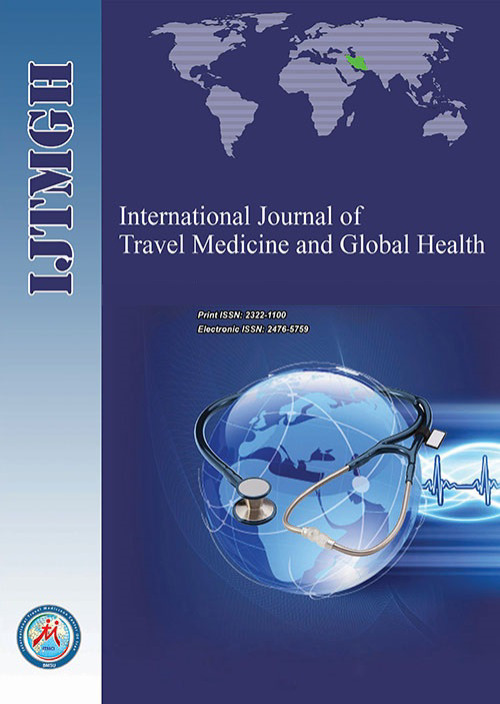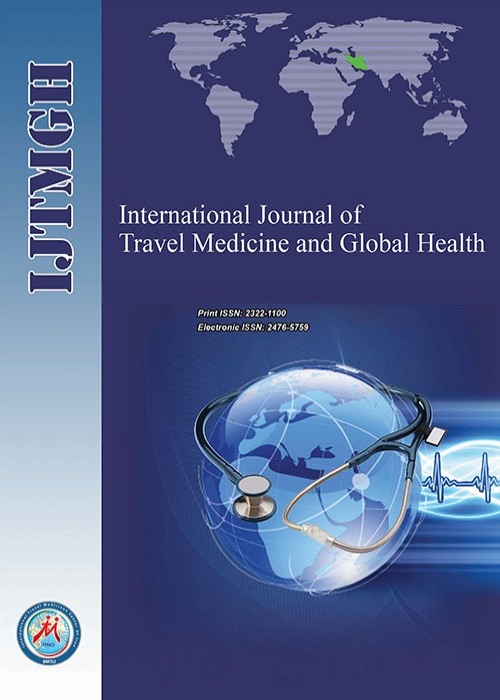فهرست مطالب

International Journal of Travel Medicine and Global Health
Volume:10 Issue: 4, Autumn 2022
- تاریخ انتشار: 1401/10/07
- تعداد عناوین: 8
-
-
Pages 137-146IntroductionEducational attainment is one of the main social determinants of health, however, based on a literature from the US, high educational attainment is associated with fewer health advantages for marginalized groups such as immigrants. A recent study has shown diminished returns of education on health. In the current study, built on the Marginalization-related Diminished Returns (MDRs) theory, the differential association between educational attainment and happiness in Europe by nativity status is tested.MethodsFor this cross-sectional study, we borrowed data from European Social Survey 2020 (ESS 2020). Participants included 9560 individuals who identified as either native-born (n = 9052) or immigrant (n = 508) individuals who had worked in the past week and were residing in one of these ten countries: Bulgaria, Czechia, Estonia, Finland, France, Croatia, Hungary, Lithuania, Slovenia, and Slovakia. Age, sex, and self-rate health were control variables, while educational attainment was the independent variable. Happiness was the outcome. Linear regression was used for data analysis. Poisson regression was used for sensitivity analysis.ResultsOverall, high educational attainment was associated with higher levels of happiness. We documented a statistical interaction between nativity status and education on happiness, indicating a weaker inverse association between educational attainment and happiness for immigrant than native-born individuals. The results remained similar using linear or Poisson regression models.ConclusionSimilar to the US, the link between educational attainment and happiness also depends on nativity in Europe. Countries of host undervalue the educational attainment of immigrants. Future research should explore the role of labor market discrimination and other racialization and xenophobia on reducing the return of education for immigrants. Given the existing MDRs, and because diminished returns are a mechanism behind disparities, policymakers should go beyond equal SDOH and equalize the return of SDOHs. Policies such as equal pay and additional enforcement of antidiscrimination may help. The results are important given the anti-immigrant sentiment and nationalist movements in Europe and around the world.Keywords: Education, income, Immigrants, Happiness, Socioeconomic status, Population Groups, Nativity
-
Pages 147-154
The greatest Ebola virus disease (EVD) epidemic in recorded history is now occurring in West Africa. The Zaire Ebolavirus (EBOV), the virus responsible for this outbreak, is a member of the genus Ebolavirus, which combined with the genus Marburgvirus makes up the family of the Filoviridae. Among the viral hemorrhagic fevers, EBOV is one of the most aggressive viruses; case fatality rates of up to 90% have been documented. Multi-organ failure and serious bleeding problems are what cause death. The WHO recorded 5335 cases (confirmed, suspected, and probable) as of September 18th, 2014, with 2622 fatalities, yielding a case fatality rate of almost 50%. With a focus on pathophysiology, clinical symptoms, and therapeutic options, this review aims to provide an overview of EVD for clinicians.
Keywords: Ebola virus disease, Pathogenesis, Diagnosis, treatment, filovirus -
Pages 155-158
Parkinson disease is a progressive neurodegenerative disorder affecting the dopaminergic neurons of the basal ganglia, affecting approximately 1% of individuals over the age of 65. The travel health challenges of patients with Parkinson disease have not been adequately addressed in the medical literature. This perspective article discusses the barriers to healthy travel in this vulnerable population and considers mitigating measures. It focuses on difficulties with mobility, cognitive impairment, chronic medications, and medical devices.
Keywords: Parkinson disease, Movement Disorder, Accidental falls, Travel Medicine -
Pages 159-165BackgroundAlthough high socioeconomic status (SES) is known to be associated with low-risk behaviors, the effects of high family SES may be weaker for racial and ethnic minority than majority youth.AimWe compared the association between family SES and peers’ tobacco use risk between majority and minority youth in the US.MethodsWe used four years of follow up data from the Population Assessment of Tobacco and Health (PATH-Youth) study. All participants were 12 to 17 years old at baseline and were successfully followed for four years. 4652 Non-Latino and Latino White and Black youth were enrolled. Outcome was peers’ tobacco use risk at year four, treated as a continuous measure. Predictor was baseline parental SES, as a proxy of family SES. Moderator was racial and ethnic minority status. Covariates were age, gender, and family structure at baseline.ResultsOur linear regressions in the pooled sample showed that higher family SES at baseline was associated with a lower level of peers’ tobacco use risk at year four, however this association was weaker for minority than majority youth. Our stratified models also showed that higher family SES was associated with a lower level of peers’ tobacco use risk for majority but not for ethnic minority youth.ConclusionThe presumed protective effect of high family SES against peers’ tobacco use risk varies between diverse ethnic groups of youth. Future research should test the role of school and neighborhood climate on weakening the protective effects of family SES for minority than majority youth. The role of high-risk schools and neighborhood environments and other contextual conditions should be tested in future multi-level research.Keywords: Population Groups, Risk Behavior, Peers’ tobacco use risk, Ethnic Groups, tobacco use, Peer pressure
-
Pages 166-168
People living with cystic fibrosis (CF) are believed to perform poorly at high altitude. The advent of cystic fibrosis transmembrane conductance regulator (CFTR) modulators has transformed patient care, making high-altitude trekking an attainable goal for most patients living with CF. We consider how an amateur trekker with CF who wishes to climb a high mountain such as Kilimanjaro (5895m) should be advised. Since symptomatic pulmonary hypertension is a contraindication to high altitude travel, CF patients with pulmonary hypertension should use supplemental oxygen and take nifedipine for HAPE prophylaxis. There is no contraindication to the use of prophylactic acetazolamide in CF. With the success of CFTR modulators, it may no longer be necessary to optimise the CF patient’s clinical status with an inpatient course of intravenous antibiotics in advance of high-altitude travel. High-altitude trekkers with CF should use volumatic spacers with their inhalers and portable nebulisers. They should continue to take their regular medications, including mucolytic agents and prophylactic oral antibiotics. Monitoring oxygen saturation using a pulse oximeter may be useful. On the Kilimanjaro trek, a longer climbing route such as Lemosho is preferred as it allows more time for acclimatisation to hypoxia. A formal medical fitness-to-travel assessment by a respiratory physician may be mandated by insurance companies. Close liaison between respiratory and travel medicine specialists will best serve the needs of high-altitude trekkers with CF.
Keywords: High Altitude, cystic fibrosis, Respiratory, Chronic Disease -
Pages 169-173IntroductionMillions of chronic hepatitis B virus (HBV) affected people live around the world. Although, the progress in vaccination and treatment has been changed the picture of hepatitis B . According, hepatitis b health-related stigma as a barrier for health service use, still shows its important role. The current study aimed to understand the social knowledge and stigma of HBV in a selected community of Iran.MethodBased on a well-defined study design and through the cross-sectional hospital-based study ,we recruited 860 hepatitis B affected people. After informing about the purpose of the research, each men or women that referred to these hospitals and were satisfied could enter the study. Interviews were carried out with individuals’ informed consent. Stigma and knowledge questionnaire need to be finished independently within a 20-minues. . We applied The EMIC stigma scale for evaluating the stigma. The mean , standard deviation and multiple linear regression models was used to analysis the data that carried out with SPSS 21 software.ResultThe 860 participants (39.88% males ,60.11% females) were entered. The distribution of age among respondents were 32.43±8.1 years. The total mean score of stigma in this study was 3.86 that was greater than 2 represents a strong perception among participants. Also, in some domains such as the shame or embarrassment, worthless considering, believe in adverse effect on others, community avoidance and refuse to get patients home, disclosure and marriage, the score of stigma was apparently heavier than the other domains.ConclusionA lot of health care promotions have been occurred in the area where the hepatitis B isn’t endemic area but stigma still a remained concern. This study showed that there is a relationship between the stigma, knowledge of people, being single, unemployment and younger age of affected people.Keywords: Hepatitis B, Stigma, psychology, emotional health
-
Pages 174-175
-
Pages 176-185PurposeTelemedicine is a concept with a history of several decades, which means providing medical and therapeutic services remotely using information and communication technology. This issue requires the transfer and flow of medical and therapeutic knowledge from specialists to those in need, and in this context, the importance of knowledge logistics can be realized in order to identify the need and provide a solution in the telemedicine process. Therefore, the aim of the current research is to review the concepts of these two fields and identify their common points in order to identify the application of knowledge logistics in telemedicine.MethodologyThe current research is of applied type and using Scientometric method. At First, a descriptive review of the available resources with related keywords such as logistics, knowledge logistics, medical knowledge logistics, telemedicine and knowledge logistics in telemedicine was done in Google, Google Scholar and Sid databases, and in the second part, to determine the relationship Between the two concepts, the terms knowledge logistics and telemedicine were searched in Scopus and PubMed databases on March 3, 2022, and the outputs of each database were discussed.FindingThe findings show that for nearly two decades and the upward trend of special resources in recent years, a major part of the United States has been in the production of resources, history and growth of resources related to two areas. Also, Anderson as the most prolific writer, the Journal of Internet Medical Research has a stronger relationship with BMC Medical Informatics and Decision Making. Finally, there is an occurrence of the keywords of logistic models in the resources related to the field of telemedicine, and knowledge has an important place in the resources related to the field of telemedicine.ConclusionThe results showed that the position of knowledge and knowledge management in the field of telemedicine, considering its little history, but the exponential growth during these years is very impressive, and since knowledge logistics models are related to the resources of this field, therefore It can be considered a new and practical concept in this field.Keywords: Telemedicine, Knowledge logistics, Telemedicine knowledge logistics, Knowledge Management


